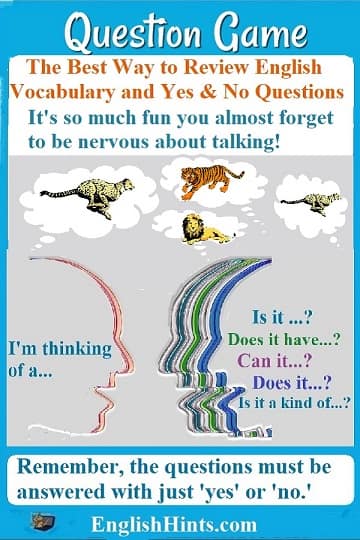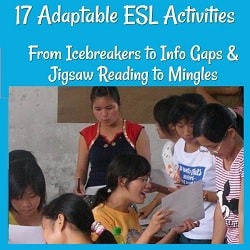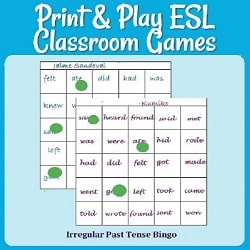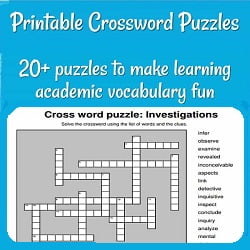The Question Game: Guess what I'm Thinking about
The Question Game is one of the most useful (and fun!) language games I know. (It's also called 20 Questions, the Yes or No Game, or Guess what I'm Thinking of.)
It lets you practice asking and answering questions. It also reminds you of so much that you already know, both the names of things and the categories they fit into.
Instructions:
One person (the “thinker”) starts the game by saying, “I’m thinking of something (or someone) that (or who, if a person) is...”
The thinker then tells the other players the category they will guess from.
It can be
- an animal,
- a plant,
- a food,
- a household or classroom object,
- an occupation,
- an historical figure,
- a famous actor,
- even a mutual friend-- anything or anyone known to all the players.
(It’s not fair to choose something some players might not know!)
Then other players ask questions to see who can be first to guess what the “thinker” has in mind. Before trying to guess the exact answer, players ask questions to “narrow down” the possibilities.
The challenge is that the “thinker” must answer truthfully, but will only answer “yes” or “no” (or “sometimes.” He or she may also give hints, if necessary.)
Here’s an Example:
The thinker says “I’m thinking of an animal.” (“An animal” means some kind of living creature, not meat or things made from leather, etc.)
Players ask questions about various categories to eliminate some possibilities. Useful categories include:
-- where the animal usually lives (continent, habitat, etc.),
-- what it looks like (size, color, wings or scales or fur, etc.),
-- what it eats,
-- its abilities and usual activities, etc.
Remember that the Question Game requires yes or no answers. So if we want to know what color it is, we may not ask “what color is it?” Instead we can ask, “Is it brown?” (or “Can it be brown?” or “Is it partly brown?”) So different people might ask:
-- Is it native to North America? -- No.
-- Is it native to Africa?-- Yes.
-- Does it eat meat?-- No.
-- Is it bigger than a big dog?-- Yes.
-- Is it a giraffe?-- No.
-- Does it live in other places besides Africa (not counting zoos?)-- Yes.
-- Is it an elephant?-- Yes.
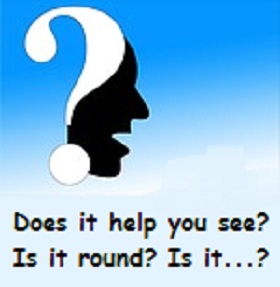
The person who guessed the right answer is the winner of this round, and will usually be the next “thinker.”
Players (or the teacher) can decide beforehand if all the questions today will be about animals, or if each “thinker” can choose a new topic. (“I’m thinking about a famous inventor...”)
The thinker tries to find something that all players will know without being too easy to guess. One of the best-- and hardest-- rounds my class ever played was using the topic “foods.” One thinker chose “chocolate.”
Someone asked “Is it made with beans?” The thinker said yes, so we started guessing soybeans and tofu, refried beans and green beans. We forgot all about desserts!
Variations
The Question Game is sometimes called 20 Questions because in one version each questioner is only allowed 20 questions.
If no one can guess before everyone has “used up” their questions, the “thinker” wins.
In my classes we usually don’t count questions. We just want to “narrow down” the possibilities and discover the answer as quickly as possible.
The fun is in the thinking and guessing, anyway.
There’s also a version of this question game called Animal, Vegetable, or Mineral. (Here 'vegetable' means any plant, or something made from a plant, and 'mineral' means a non-living material like metal or stone.)
The thinker announces one of those categories and players guess the object made from one of those. (Animal might be a pig, bacon, an eagle, an alligator, or an alligator purse, etc.)
Ways to Use the Question Game Outside of Class
I love the Question Game! It can be played anywhere, without preparation or equipment. Because it requires imagination, it’s a favorite game for native speakers too.
It’s a good party game, useful as an “ice-breaker” for getting to know people. (You can learn a lot about your friends' interests and imaginations without investing in boxed games.)
It can “save the day” when children start getting restless at the doctor’s office or on long car rides. (I kept two children amused at the airport with it once.) It can be played with a whole class or a few friends. (It's faster and more exciting with more than two players.)
Try the Question Game with a few friends, using whatever categories you are interested in (space, your country’s history or geography, favorite foods...) Just remember to ask questions like “is it...?,” “does it ever...?,” not Wh- questions like “what is...?” or “where does it...? Use your imagination-- and your English.
Related Pages
Short activities: icebreakers, warm-ups, mingles, role plays, and games +. You’ll want these in your toolkit!
Games are so useful in ESL classes! Get free printable puzzles, vocabulary matching games, and inexpensive packets of games to practice irregular verbs.
Crossword Puzzles are a great way to make vocabulary study more fun. These can be printed for practice offline.
Home> ESL Games> The Question Game.
Didn't find what you
needed? Explain what you want in the search box below.
(For example, cognates, past tense practice, or 'get along with.') Click to see the related pages on EnglishHints.
| site search by freefind | advanced |
